Who else during this coronavirus pandemic has missed dining out? I know I have, especially in a city like Tokyo which offers some of the top restaurants in the world. Dining out was off-limits for some time during the height of the pandemic and amid Tokyo’s multiple state of emergency declarations, but it is nice to have some form of a return to normalcy as more diners start eating out again. The restaurant industry has certainly changed dramatically in the past year and a half, but it has been quite amazing to witness how so many Japanese people make personal efforts to support their local restaurants and cafes.
最近のコロナ禍の中、皆様は外食をしたいと思いましたか?特に東京のような世界でもトップレベルのレストランがある都市では、私もそうでした。
パンデミックの最中、そして東京が何度も緊急事態宣言を出している間、外食はしばらく禁止されていましたが、外食を再開する人が増えてきて、少しずつ平常に戻ってきているのは嬉しいことです。この1年半で外食産業は劇的に変化しましたが、多くの日本人が個人的に近隣の飲食店やカフェを支援する努力をしていることに心が洗われるようでした。
To me, nothing is quite as exciting as the thrill of trying out new dishes and new restaurants. The coronavirus pandemic has made me appreciate even more the novelty of diving into exotic dishes that were not prepared at home. No doubt that all this extra time at home has allowed us to hone our cooking skills and discover new recipes, but it is still nice to be able to just sit down and simply appreciate good food, rather than worrying about preparation (or in my case, burning down the kitchen >.<;).
Hence, when I was invited to try a new Gibier Cuisine restaurant for JNTO’s (Japan National Tourism Organization) “Taste Tour Japan” series featuring Japanese Food and Restaurants, I jumped at the opportunity!
Check out my article, “Taste of the Wild! Explore the new frontiers of Japan’s wild game cuisine,” featured on JNTO’s website!
私にとって、新しい料理や新しいレストランを楽しむことほどワクワクすることはありません。今回のコロナ禍で、家では作らなかった異国の料理を食べることの新鮮さをより強く感じるようになりました。家にいる時間が増えたことで、料理の腕を磨いたり、新しいレシピを発見したりすることができたのは嬉しいですが、準備に気遣いをすることなく(私の場合はキッチンを焼いてしまうこともありますが … >.<; )、ただ座って美味しい料理を味わうことができるのは、やはり幸せですね。
ですので、JNTO(日本政府観光局)の「Taste Tour Japan」シリーズで日本の食とレストランを特集するにあたり、新しいジビエ料理レストランに招待されたとき、私はその機会に飛びつきました!
私の記事、「Taste of the Wild! 日本のジビエ料理の新境地を探る」がJNTOのウェブサイトに掲載されました。ぜひご覧いただければと思います。
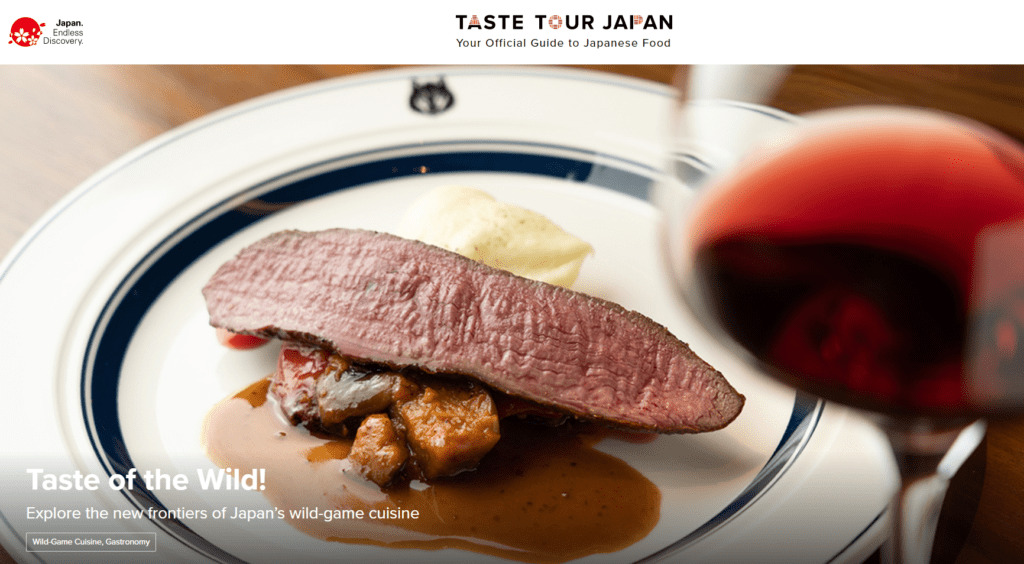
Taste of the Wild! | TASTE TOUR JAPAN | Your Official Guide to Japanese Food | Japan National Tourism Organization (JNTO)
https://dining.japan.travel/en/article/o_15/index.html
Note: All images are sourced from the original JNTO article. Excerpts of this blog article were originally published on JNTO.
注:使用されている画像はすべてJNTOのオリジナル記事から出典しています。このブログ記事の抜粋はJNTOに掲載されたものです。

Table of Contents
- Elegant Japanese Gibier Cuisine at Elezo Gate
- エレゾゲートの優雅な日本のジビエ料理
- The Difference with Japanese Jibie Cuisine
- 日本のジビエ料理との違いとは
- Healthy and Sustainable Wild Game Meat
- 健康的で持続可能な野生動物の肉
- Final Thoughts
- 最後によせて
- Other Articles on Food and Travel in Japan
Elegant Japanese Gibier Cuisine at Elezo Gate
エレゾゲートの優雅な日本のジビエ料理

It was my first time to dine on a 3-course meal of Japan’s wild game cuisine at the newly opened Elezo Gate in the Toranomon Hills Yokocho.
The term Gibier (meaning “wild animal hunted for food” or “game”) is known as “jibie”(ジビエ) in Japanese, but originates from the French language. Although it is often seen as the traditional food of European nobility, it has been used in Japanese cuisine since ancient times, with time-honored game-meat dishes—such as momiji stew, having venison as its key ingredient, and botan stew, featuring boar meat—being a mainstay in rural life.
虎ノ門ヒルズの虎ノ門横丁に新しくオープンした「エレゾゲート」で、日本のジビエ料理の3コースを食べるのは初めてのことでした。
「Gibier」とは、「食用のために狩られた野生動物」や「狩猟」を意味する言葉で、日本語では「ジビエ」と呼ばれていますが、フランス語が語源です。ジビエというと、ヨーロッパの貴族の伝統的な食べ物というイメージがありますが、日本では古くからジビエ料理が食べられており、鹿肉を使った「もみじ煮」やイノシシ肉を使った「ぼたん煮」など、農村の生活に根付いた料理が色々あります。
The popularity of “jibie” in Japan declined after the Meiji period (1868–1912) when farm-raised beef and pork became prevalent throughout the country. But recently, after a long hiatus, wild game meats have been gaining popularity in Japan’s culinary world as a healthy and sustainable food that is low-calorie, low-fat, yet high protein.
In Tokyo, the number of restaurants serving jibie dishes is on the rise, from traditional Japanese nabe (hot-pot) and shabu-shabu restaurants to European bistros and fine-dining establishments. Jjibie cuisine is quickly becoming sought after once again in Japan. The challenge, however, is to make jibie cuisine that appeals to Japanese diners, which means the meat must be carefully sourced and cooked to create tasty, hearty dishes without a strong gamy flavor. This preference for high-quality meat is, more than anything else, what sets contemporary game cuisine apart from its rustic forebears.
日本では、明治時代(1868〜1912)に牧場で育てられた牛肉や豚肉が全国的に普及した後、「ジビエ」の人気は低下しました。しかし最近では、長らく途絶えていた野生のジビエ肉が、低カロリー、低脂肪でありながら高タンパクという、健康的で持続可能な食品として、日本の食の世界で人気を博しています。
東京では、日本の伝統的な鍋料理やしゃぶしゃぶの店から、ヨーロッパのビストロや高級レストランまで、ジビエ料理を提供する店が増えています。日本でもジビエ料理が再び求められるようになってきたのです。しかし、日本の消費者に受け入れられるジビエ料理を作ることが最大の課題です。つまり、狩猟性の強い味ではなく、美味しくてボリュームのある料理を作るために、肉を慎重に調達し、調理しなければなりません。上質な肉へのこだわりが、現代のジビエ料理を素朴な昔の料理とは違うものにしているのです。
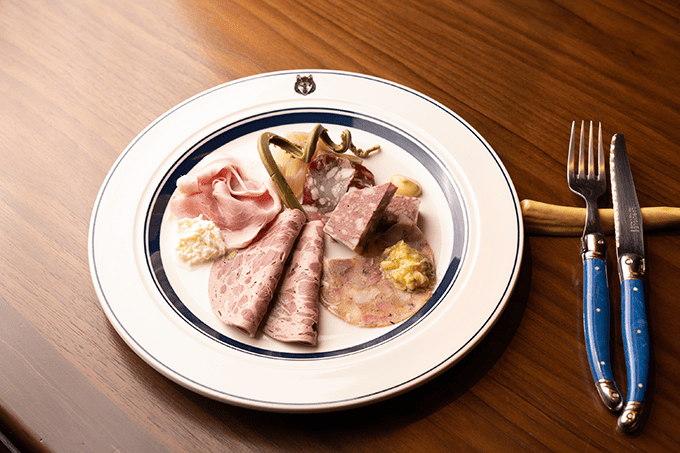
食事は、エレゾが所有する食肉加工工場で作られた鹿肉と豚肉のシャルキュトリープレートから始まりました。鹿の角はシックなカトラリーホルダーにもなっています!
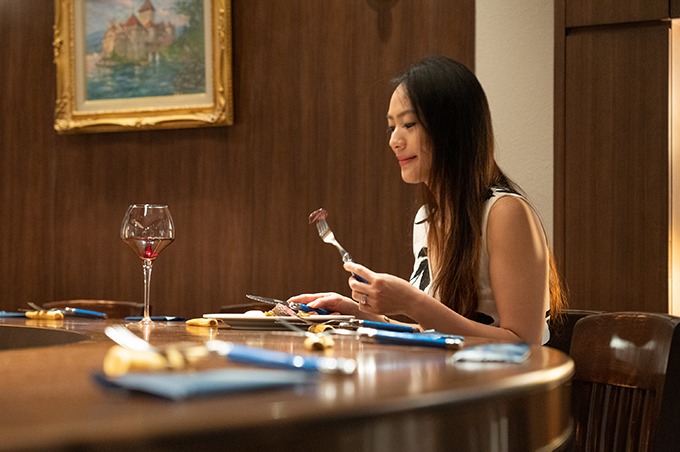
野生鹿肉のステーキを赤ワインと一緒に味わう。思っていた以上にジューシーで柔らかく、繊細な味がしました!
Unlike the impression I had of Japanese wild game meats as something you would have in an izakaya or roadside stall in rural areas, the contemporary bistro ambiance and plating of each dish at Elezo Gate made it a chic dining experience.
Elezo Gate emphasizes its high-quality meat and its use of all parts of an animal without wastage. The restaurant’s goal is to always create dishes that bring out the natural flavors of the meat. At Elezo Gate, all seasonings, including sauces and spices, and even the wines offered with the meal, are specially curated to complement the ingredients in meat dishes without overpowering the genuine flavor of the meat itself.
日本の野生動物の肉は、地方の居酒屋や屋台で食べるものというイメージがありましたが、「エレゾゲート」では、現代的なビストロの雰囲気と一品一品の盛り付けで、シックな食事を楽しむことができました。
エレゾゲートでは、上質な肉と、動物のすべての部位を無駄なく使うことを大切にしています。肉本来の味を生かした料理を目指していて、ソースやスパイスなどの調味料、そしてワインも、肉本来の味を損なうことなく、肉料理の素材を引き立てるために特別に作られています。
The Difference with Japanese Jibie Cuisine
日本のジビエ料理との違いとは

エレゾグループの佐々木翔太社長が、ジビエ料理への思いを語る。
The Elezo Group was established in 2005 as a meat processing and distribution business in Obihiro, Hokkaido. It has since expanded to include a variety of brands and now operates as an integrated meat production and management system. Although Elezo Gate does not specialize solely in jibie cuisine, it has become well known in Tokyo as a gateway to the world of game.
エレゾグループは、2005年に北海道帯広市で食肉の加工・販売事業を行う会社として設立されました。その後、さまざまなブランドを展開し、現在では食肉の生産から管理までを一貫して行っています。エレゾゲートはジビエ料理だけに特化しているわけではありませんが、ジビエの世界への入り口として東京ではよく知られています。
Did You Know?
ご存知でしょうか?
Did you know that in Japan, most game is hunted in the prefectures of Hokkaido and Mie? Unlike wild game meats used in other countries, Japanese jibie cuisine is renowned for its delicate, clean flavor. The game meat derives its “gamey” taste from what the animal eats.
日本では、ジビエのほとんどが北海道と三重県で捕獲されていることをご存知でしょうか。日本のジビエ料理は、他の国で使われる野生のジビエ肉とは異なり、繊細でクリーンな味わいが特徴です。ジビエ肉の野生的な味は、動物が食べたものに由来しています。
From speaking with Sasaki-san, the CEO of Elezo Group and an avid gibier cuisine fan, I learned that the freshness and proper processing of wild game meat are crucial to lessening the wild taste and increasing the tenderness of the jibie.
For example, Elezo Gate uses only deer meat from animals that are about two years old so that the steak is more succulent. It takes about three weeks for Elezo’s meat-processing plant to prepare the meat before it is shipped to the restaurant.
ジビエ料理をこよなく愛するエレゾグループ代表の佐々木社長にお話を伺ったところ、ジビエの野性味を抑え、柔らかさを増すためには、野生動物の肉の鮮度と適切な処理が重要であることがわかりました。
例えば、エレゾゲートでは、よりジューシーなステーキにするために、生後2年程度の鹿肉のみを使用しています。レストランに出荷されるまでには、エレゾの食肉加工工場で約3週間かけて調理されます。
The biggest challenge in preparing and serving jibie meats is managing sanitation properly. Poorly sourced wild game can carry viruses and other parasites, which are generally well controlled in farm-raised animals, such as pigs and cows. In 2014, Japan’s Ministry of Health, Labour and Welfare set strict guidelines for hygiene in handling wild game to maintain food safety. Each step in the process must be carefully monitored, from hunting and transport of the animal to butchering, processing, preparing, and selling its meat—in other words, everything from capture to consumption.
It is, however, difficult for restaurants that purchase game meat from various slaughterhouses to ensure high standards of hygiene and the authenticity of the jibie meat. The Elezo Group prides itself on its A-to-Z operations, where game meat is acquired directly from the hunter and the entire preparation process is completed at designated Elezo meat-processing plants. Elezo requires that all the hunters it works with deliver the game to the meat-processing plant within two hours of taking the animal.
ジビエ肉を調理して提供する際の最大の課題は、適切な衛生管理です。野生のジビエ肉を粗末に扱うと、ウイルスやその他の寄生虫を媒介する可能性がありますが、豚や牛などの農場で飼育されている動物では一般的によく管理されています。日本の厚生労働省は2014年、食の安全を維持するため、野生動物を扱う際の衛生管理について厳しいガイドラインを定めました。狩猟、輸送、精肉、加工、調理、販売まで、つまり捕獲から消費までの各工程を注意深く監視する必要があります。
しかし、様々な食肉処理場からジビエ肉を購入しているレストランでは、ジビエ肉の高い衛生基準と真正性を確保することは困難です。エレゾグループは、狩猟者から直接ジビエ肉を仕入れ、エレゾの指定する食肉加工工場ですべての調理工程を行う「A-to-Z」のオペレーションを行っています。狩猟者は捕獲後2時間以内に食肉加工工場に搬入することが義務づけられています。
Healthy and Sustainable Wild Game Meat
健康的で持続可能な野生動物の肉
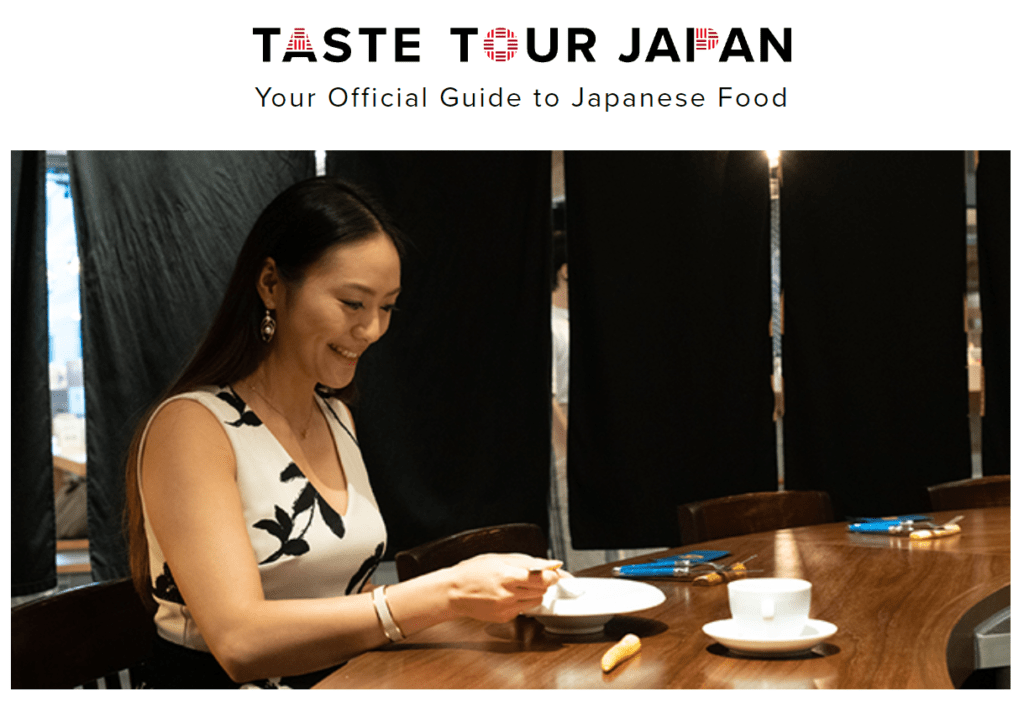
ジビエ料理を楽しみながら、日本の地方自治体に貢献しましょう!
On the subject of sustainability, Sasaki comments that the rise of a jibie food culture in Japan would benefit rural prefectures, since deer and other wild animals cause significant damage to many agricultural regions. With jibie cuisine, game could be viewed as a gift from nature, since it would be hunted to give consumers a nutritious culinary experience, instead of being culled as a pest.
Don’t forget to read the rest of the article here!
持続可能性について、佐々木社長は、鹿などの野生動物が多くの農業地域に大きな損害を与えていることから、日本でジビエ料理の文化が台頭することは、地方の県にとって有益であると話していただきました。ジビエ料理では、ジビエを自然からの贈り物として捉えることができます。なぜなら、ジビエは厄介者として駆除されるのではなく、消費者に栄養価の高い料理を提供するために狩られるからです。
記事の続きはこちらをぜひご覧ください!
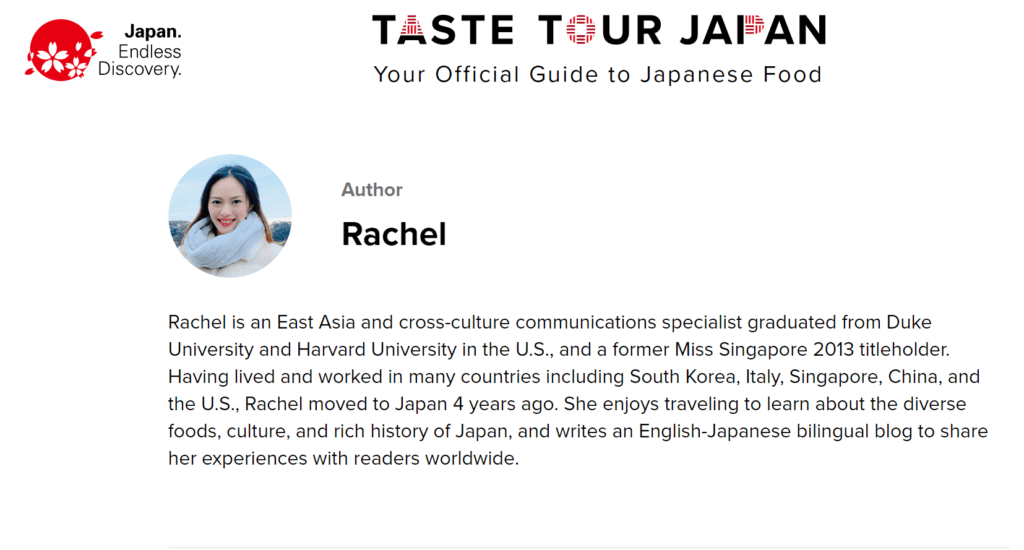
JNTOのウェブサイトに掲載された私のプロフィール。JNTOの「Taste Tour Japan」レストランガイドシリーズに貢献できて嬉しいです。^^
Final Thoughts
最後によせて
Dining at Elezo Gate was a refined culinary journey into Japanese jibie cuisine – a very different experience compared to my past encounters with wild game meats in other countries (from pigeon pie, venison stew, and roast pheasant in the U.K., to “bush meats” such as grilled kangaroo and seared emu fillets in Australia, and even barbecued zebra, impala, or hartebeest in Namibia). I was very impressed by how clean the meats tasted – they were not gamey at all!
In 2014, Japan’s Ministry of Health, Labour and Welfare set strict guidelines for hygiene in handling wild game to maintain food safety. Each step in the process must be carefully monitored, from hunting and transport of the animal to butchering, processing, preparing, and selling its meat—in other words, everything from capture to consumption. An exceptional level of attention to detail is required to achieve high standards of hygiene and consistency in the meat preparation process. I suppose the same idea that lies behind the processing of Japan’s treasured wagyu beef to achieve a sophisticated flavor and tenderness is also carried over to the country’s wild game meats.
エレゾゲートでの食事は、日本のジビエ料理への優雅な旅でした。これまで他の国で野生動物の肉を食べたことがあるのですが(イギリスでは鳩パイ、鹿肉シチュー、キジのローストや、オーストラリアではカンガルーのグリルやエミューのフィレの炙りなどの「ブッシュミート」や、ナミビアではシマウマ・インパラ・ハーテビーストのバーベキューなど)、それとは全く異なる体験でした。私は日本のジビエ肉がとてもきれいな味であることに感銘を受けましたー全く「Gamey」(野生的な味)がありませんでした。
2014年、日本厚生労働省は、食の安全性を維持するために、野生動物を扱う際の衛生面での厳しいガイドラインを定めました。野生動物の狩猟、輸送、食肉処理、加工、調理、販売まで、つまり捕獲から消費までのすべての過程を注意深く監視しなければなりません。衛生的で一貫性のある食肉加工を実現するためには、並々ならぬ注意が必要です。日本の宝である和牛を洗練された味と柔らかさに仕上げる発想は、日本の野生動物の肉にも受け継がれているのではないでしょうか。
I was also surprised to learn from Sasaki-san that Elezo Gate also occasionally serves rare wild game dishes such as Hokkaido Black Bear (higuma) and the Japanese Rock Ptarmigan (raicho)! (Raicho – literally translated as “thunder bird” – is the official bird for Gifu, Nagano, and Toyama Prefectures and are listed as a special protected endangered species.)
また、佐々木さんに伺って驚いたのですが、エレゾゲートでは時折、北海道の樋熊や雷鳥のような希少なジビエ料理を提供することがあるそうです。(雷鳥は、岐阜県・長野県・富山県の公式な鳥で、特別天然記念物に指定されています。料理の為の狩猟目的ではなく、特別な理由があるときだけです。)
While ptarmigans are often thought of as alpine birds, some ptarmigans also spend the winters along the shore in such places as the Kamchatka Peninsula and the North America’s Hudson Bay. In Japan, tundra-inhabiting rock ptarmigans can be found in the Chubu Mountain region, and the forest-inhabiting hazel grouse can be found in Hokkaido. The rock ptarmigans found in the Chubu region came to the area during the ice age, and then migrated back north as the climate warmed and the glaciers retreated. At that time, a group of rock ptarmigans found a suitable climate in the mountains and became isolated. Like their counterparts which inhabit the European Alps and Pyrenees, they represent a population left behind during migration after the ice age.
Japanese rock ptarmigan profile | Raicho Mimamori Net (raicho-mimamori.net)
ライチョウというと高山の鳥と考えてしまいがちですが、カムチャッカ半島や北アメリカのハドソン湾では、冬に海岸周辺でも生息している鳥です。日本には中部山岳にツンドラ性のライチョウ、北海道に森林性のエゾライチョウが生息しています。
中部山岳に生息するライチョウは、氷河期に南下し、気候の温暖化による氷河の後退とともに北方に移動した際、一部が北方とよく似た気候の高山にとり残された個体群で、ヨーロッパアルプスやピレネー山脈のライチョウとともに、氷河期の遺留種(遺留個体群)とされています。
ライチョウのプロフィール | ライチョウ見守りネット (raicho-mimamori.net)
For jibie cuisine enthusiasts, I do not doubt that these rare menu dishes would be quite the attraction.
If you are looking for a new experience in meat cuisine as well as a healthy alternative to beef and pork, why not give Japan’s jibie cuisine a try? The animals are sourced from the Japanese hinterland, where their meat has long been part of the diet of local hunters. Available game meats change with the seasons, and there are various ways to prepare and enjoy them year-round.
Have you had Japanese wild game cuisine before? What do you think about “Jibie” and Gibier Cuisine in Japan? I would love to hear about your thoughts and experiences! Please do leave me a comment or send me an email by subscribing to me newsletter. I look forward to hearing from you! 🙂
ジビエ料理愛好家にとっては、このような珍しいメニューがあれば、かなりの魅力になることは間違いありません。
新しい肉料理を体験したい、牛肉や豚肉に代わるヘルシーな食材を探しているなら、日本のジビエ料理を食べてみませんか?ジビエとは、日本の内陸部で捕獲された動物のことで、昔から地元の猟師たちの食生活には欠かせないものでした。ジビエ料理は、季節に応じて様々な調理法で楽しむことができます。
日本のジビエ料理を召し上がったことはありますか?日本の「ジビエ」や「ジビエ料理」についてどう思われますか?皆様のご意見や経験をぜひお聞かせください。お気軽にコメントをお寄せください。また、メールマガジンをご購読くださいね♪ ご連絡をお待ちしております。










